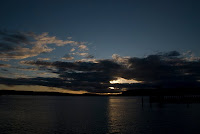HDR or High Dynamic Range photography has been a concept that has been around since 1997. Your camera sees a dynamic range of roughly 6 f-stops. Let me explain that a little further with the use of some images. By merging the images together and performing some post processing techniques we can try to get that range up to 11 f-stops. Still far below what our eyes can see but a huge improvement in tonal range.
This image is over exposed by 2 f-stops
This image is underexposed by 2 f-stops
This image is exposed correctly and is a pretty good image by itself. Well what we are about to do is do some digital magic.
We are going to merge these three photos together in photoshop with an automate function of "Merge to HDR". This will automatically line up your images and put one on top of the other. Photoshop does a great job of aligning images. What it does not do so well is a process called "tone mapping". Tone mapping is where your will bring out all the details and the range of the image. I use a product called Photomatix. This seems to be the industry standard. There are several other programs that offer similar results such as FDRsoft, Qtpfsgui, and Picturenaut. Once Photoshop has merge your image you will need to save it as a 16 bit tiff file. This file size and type provides you more flexibility in bringing out the details and highlights.
Open up Photomatix and then open your tiff file. Then play around with the sliders and see what kind of image you can produce.
If you don't have Photoshop, Photomatix does a very good job at merging an image to HDR. So, essentially, Photomatix could be your one stop HDR software.
Here is our final image. It is a much deeper, more vibrant image.
For more examples of HDR you can visit my website timbarronphoto.com or visit my fan page on facebook at Tim Barron Photography




